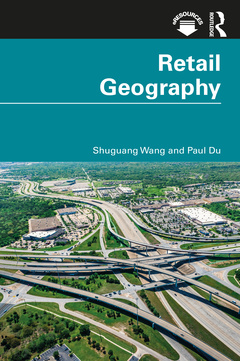Retail Geography
Auteurs : Wang Shuguang, Du Paul

The retail sector is an integral part of a national economy. From the political economy perspective, all consumer goods have surplus values locked up in them; the surplus values are not realized until the consumer goods are purchased by consumers through various distribution channels. As such, retailing is the essential link between production and consumption.
The success of a retail business depends on two general factors: the location of the retail outlet, and management of the business. Both factors are equally important. If the business is located in the wrong place with the wrong customer base, it will not generate expected sales. Similarly, if the business is poorly managed and operated, it will not perform well even if the location is right. Influenced by both traditional and new location theories, Retail Geography is conceptualized and organized using the retail planning process as the framework. The technical and methodological chapters help guide the reader with detailed descriptions of the techniques and are supported with practical examples to reflect the latest software development.
Retail Geography provides a state-of-the-art summary and will act as a core textbook for undergraduate and graduate students of economic geography interested in specializing in retail and business geography. The practical examples also make it a valuable handbook for practitioners in the field, as well as students of retail management and commercial real estate management.
1. Introduction 2. The Contemporary Retail Economy 3. The Geography of Demand, Expenditure Patterns, and Market Segmentation 4. Retail Structure Analysis 5. The External Retail Environment: Role of Regulations and Community Attitude 6. Spatial Growth Strategies 7. Market Screening, Retail Location Analysis, and Site Evaluation 8. Trade Area Delineation and Analysis 9. Store Network Planning and Location-Allocation Modelling 10. Location Analysis of Distribution Centers 11. Conclusions
Shuguang Wang is Professor of Geography at Ryerson University, Canada. He has taught retail geography for 20 years and is well versed in the various theories and methods. He has published widely on retailing topics and has presented multiple papers at international conferences. He research on this subject culminated with the publication of China’s New Retail Economy: A Geographic Perspective (Routledge, 2014).
Paul Du is an experienced spatial analyst. After obtaining a Master of Spatial Analysis degree in 2005, he worked as a GIS Analyst at Ryerson University’s Centre for the Study of Commercial Activity, Canada, for seven and a half years, where he completed many retail-related research projects. In the recent past, he collaborated with Shuguang Wang to develop and test several major retail geography labs.
Date de parution : 07-2020
15.2x22.9 cm
Date de parution : 07-2020
15.2x22.9 cm
Thèmes de Retail Geography :
Mots-clés :
Toronto Census Metropolitan Area; Retail Planning; Site Selection; Location Analysis; International Retailers; economic geography; Retail Geographers; business geography; Total Weighted Distance; Corporate spatial strategies; Census Tracts; Business site selection; Trade Area Analysis; retail environment; Location Allocation Modeling; software development; Huff Model; retail planning process; Foreign Retailers; retail outlet; Big Box Stores; national economy; Retail Capital; Omnichannel Retailing; Sam’s Club; Zoning Bylaws; Reilly’s Law; Canadian Tire; Retail Strips; Fulfillment Centers; Thiessen Polygon; Retail Structure; Buy Brand Stores; Fuzzy TOPSIS; Calculate Travel Distance



